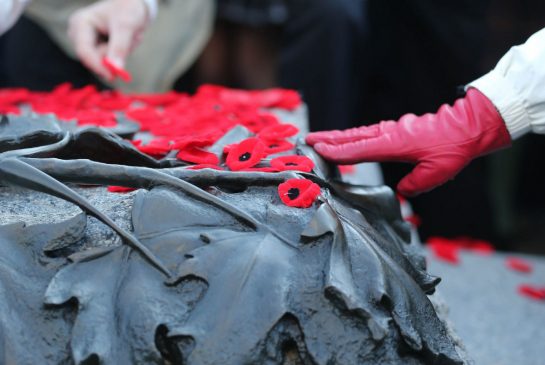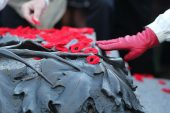Painful, raw edge to Remembrance Day ceremonies
It was all the familiar trappings of Remembrance Day, a ceremony made raw by last month’s murders of Warrant Officer Patrice Vincent and Cpl. Nathan Cirillo. On this sun-drenched day, Canadians came out in larger-than-usual numbers to pay their respects.
Dignitaries and veterans pay tribute to soldiers during a Remembrance Day ceremony at Ottawa's National War Memorial, the site where Cpl. Nathan Cirillo was shot and killed nearly three weeks ago. Rough Cut (no reporter narration).

View 2 photos
zoomSteve Russell / Toronto Star Order this photo
Poppies are placed on the Tomb of the Unknown Soldier in Ottawa on Tuesday.


OTTAWA—A hush fell across the crowd.
Among the tens of thousands who pressed against the barricades around the National War Memorial, who spilled down side streets and lined the slopes on Parliament Hill, not a whisper.
A silent, solemn tribute to soldiers lost in conflicts long ago and those lost last month. The boom of a howitzer ended “The Silence,” giving way to the mournful lament played on the bagpipes.
It was all the familiar trappings of Remembrance Day, a ceremony made raw by last month’s murders of Warrant Officer Patrice Vincent and Cpl. Nathan Cirillo by radicalized attackers.
On this sun-drenched day, Canadians came out in larger-than-usual numbers to pay their respects.
Sarah West, 38, and her husband Michael West, 47, were perched outside the British High Commission with children, Nolan, 7, Isla, 3 and Evie, 1, to get a good view.
“We have talked about what goes on during wartimes and why it’s important to remember those that sacrificed their lives for us and that we are very lucky to live when we live, because it’s peaceful,” said Sarah.
Related videos
Michael West acknowledged they were at first “apprehensive” bringing the children to the ceremony, given last month’s attacks, but thought overcoming that fear was part of the message he wanted to pass on.
“It’s important to instill that in our kids, for our children to see that, not to be scared, to stand together,” said Michael West.
Warrant Officer Kimberlee Jones, a clerk in the Royal Canadian Air Force, says the ceremony could give some “closure” to forces members still grappling with the loss of two soldiers on Canadian soil.
“This stuff that happened in October came very near and dear to our hearts. And this is our way of support,” Jones said.
Cirillo’s partner, Cpl. Branden Stevenson, watched the ceremony from a front-row seat. They were on duty together, standing sentry duty at the war memorial on Oct. 22, when a gunman fatally shot Cirillo, before attacking Parliament Hill, where he was killed by security staff.
Governor General David Johnston, in a speech rededicating the National War Memorial, urged the crowd to consider the two figures at the top of the monument — freedom and peace — and the Tomb of the Unknown Soldier at the memorial’s base.
“Because freedom without peace is agony, and peace without freedom is slavery. And we will tolerate neither,” said Johnson, wearing a military dress uniform in his role as commander in chief.
“And now look down, to the resting place of a Canadian boy who died at Vimy Ridge. We don’t know his name . . . . In anonymity he honours all Canadians who died and may yet die for their country.”

View 2 photos
zoomSean Kilpatrick / THE CANADIAN PRESS
The National War Memorial, with the dates marking the First World War is now rededicated in the name of all who have died in the service of Canada. There is a new inscription on the memorial’s granite wall — “In Service to Canada - Au service du Canada.” The dates of the Afghanistan mission and the South African War have also been added.
“We will stand on guard for him and for them, as did Nathan Cirillo, who takes his place among them. We will strive for peace and for freedom, as did Patrice Vincent, who joins them also.”
Princess Anne, in attendance at Tuesday’s ceremony, delivered a message on behalf of the Queen noting that it has been 75 years since her grandfather, King George VI, first dedicated the memorial.
“Today it is fitting that, with this ceremony of rededication, we pay tribute to all those Canadians who in the intervening years have laid down their lives in the service of peace, justice, and freedom,” the princess said.
Police estimate that 50,000 came out for the Ottawa ceremony, some 10,000 to 15,000 more than last year. Similar scenes played out across Canada.
In Toronto, hundreds of downtown workers, veterans and school children stood together on the front steps of Old City Hall and along Queen and Bay streets to pay their respects.
The solemn scene was meant to be the setting of one of Rob Ford’s last public speeches as mayor. Instead, citing health concerns as he continues cancer treatment, Ford asked outgoing Councillor Ceta Ramkhalawansingh to replace him at the podium.
Thousands gathered at Queen’s Park to pay tribute to the 1.7 million Canadian men and women who have served in uniform. But the recent deaths of Cirillo and Vincent were on the minds of many.
“Brought down by cowardice and treachery, they died in service of their country, joining a great company of others,” said Lieutenant-Governor Elizabeth Dowdeswell.
In Ottawa, veterans had a place of honour at the side of monument, blankets draped across their legs, medals gleaming in the sun. Among them was Arthur Webster, who landed in France in early July 1944.
“We went all the way through Belgium, Holland, across the Rhine and five days later the war was over,” said Webster, 89, who joined the Toronto Fire Department after the war.
“When we do have our silence, I’ll be thinking of the . . . people we lost during the conflict,” he said.
Joan Barclay Drummond got into the air force in 1942 thanks to a fib.
“I lied through my teeth to get in to the air force. I was 16. I was supposed to have been 21 in those days but was always tall and I got away with it,” she said.
“There were lots of laughs and there were lots of tears. You lost a lot of friends,” said Barclay Drummond, who served on Canada’s west coast.
For Canadian Armed Forces members at the ceremony, the recent attacks on military personnel were very much in their thoughts.
“With what happened here a couple weeks ago, with the young corporal who died, made (the National War Memorial) a sacred place for us. The blood spilled here made that place forever sacred,” said Jacques Isabel, a retired Forces member who served between 1968 and 2009 in the Middle East and Europe during the first Gulf War.
Because of the attacks, police were out in force, with some officers carrying assault rifles and tactical teams on standby a short distance away. But Ottawa Police Chief Charles Bourdeleau told the Star that the ceremony went off without a hitch.
“Our goal was to make sure it was a safe and secure environment for everyone to attend and we’ve achieved that,” he said.
After the ceremony ended, visitors flocked to the war memorial and placed their poppies atop the Tomb of the Unknown Soldier. Gail Hooper, 65, began to cry as she talked about the importance of the day.
“I always get teary on Remembrance Day, but I think it’s very important for all Canadians to come out and show their support for the current and past members of our forces,” said Hooper, from Fredericton, N.B.
“I think a lot of Canadians will maybe pause a little more after this year and think about the freedoms that we are blessed with here.”
With files from Robert Benzie and Jennifer Pagliaro
Top News
- TTC to sue Bombardier over streetcars
- Updated New carding rules can’t regulate decency and respect in policing: Cole
- Updated Raptors fans hoping for season-opening win against Pacers
- Tumour found on Rob Ford’s bladder
- Updated Melonie’s terrible last days unroll in courtroom as her father’s trial begins
- Updated Province says Cops can't arbitrarily question based on appearance
- Now Wynne wants receipts for $2.5M payouts to teacher unions
- At 19, former fashion blogger Tavi Gevinson is making her move



We value respectful and thoughtful discussion. Readers are encouraged to flag comments that fail to meet the standards outlined in our Community Code of Conduct. For further information, including our legal guidelines, please see our full website Terms and Conditions.
Commenting is now closed.
There are -- comments. Show comments.